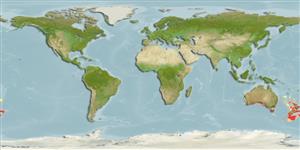Environment: milieu / climate zone / depth range / distribution range
Écologie
marin bathypélagique; non migrateur; profondeur 180 - 1000 m, usually 270 - 450 m (Ref. 9563). Deep-water; 21°S - 56°S, 113°E - 172°W
Eastern Indian Ocean and Southwest Pacific: Australia ( Western Australia, South Australia, Victoria, New South Wales and Tasmania) and New Zealand.
Taille / Poids / Âge
Maturity: Lm ? range ? - ? cm
Max length : 51.3 cm TL mâle / non sexé; (Ref. 128324); 60.7 cm TL (female)
Description synthétique
Morphologie | Morphométrie
Épines dorsales (Total): 0; Épines anales 0. Head with scarcely developed ridges; eyes large; chin barbel short; light organ small, adjacent to anus. First dorsal-fin spine smooth. Scales densely covered with lanceolate spinules, arranged in quincunx or convergent rows.
Occurs on the continental slope (Ref. 9563).
Life cycle and mating behavior
Maturité | Reproduction | Frai | Œufs | Fécondité | Larves
Cohen, D.M., T. Inada, T. Iwamoto and N. Scialabba, 1990. FAO species catalogue. Vol. 10. Gadiform fishes of the world (Order Gadiformes). An annotated and illustrated catalogue of cods, hakes, grenadiers and other gadiform fishes known to date. FAO Fish. Synop. 125(10). Rome: FAO. 442 p. (Ref. 1371)
Statut dans la liste rouge de l'IUCN (Ref. 130435)
Menace pour l'homme
Harmless
Utilisations par l'homme
Pêcheries: intérêt commercial mineur
Outils
Articles particuliers
Télécharger en XML
Sources Internet
Estimates based on models
Preferred temperature (Ref.
123201): 6.9 - 12.5, mean 9.2 °C (based on 58 cells).
Phylogenetic diversity index (Ref.
82804): PD
50 = 1.0000 [Uniqueness, from 0.5 = low to 2.0 = high].
Bayesian length-weight: a=0.00129 (0.00082 - 0.00202), b=3.14 (3.01 - 3.27), in cm total length, based on LWR estimates for this species & (Sub)family-body (Ref.
93245).
Niveau trophique (Ref.
69278): 3.7 ±0.53 se; based on food items.
Résilience (Ref.
120179): Faible, temps minimum de doublement de population : 4,5 à 14 années (Assuming tm>4).
Fishing Vulnerability (Ref.
59153): Moderate vulnerability (44 of 100).
Climate Vulnerability (Ref.
125649): Moderate to high vulnerability (50 of 100).
Nutrients (Ref.
124155): Calcium = 27.4 [8.4, 64.0] mg/100g; Iron = 0.335 [0.146, 0.913] mg/100g; Protein = 17.7 [15.3, 19.8] %; Omega3 = 0.108 [0.043, 0.281] g/100g; Selenium = 17.8 [6.1, 48.3] μg/100g; VitaminA = 33.6 [4.3, 256.2] μg/100g; Zinc = 0.496 [0.269, 0.973] mg/100g (wet weight); based on
nutrient studies.
